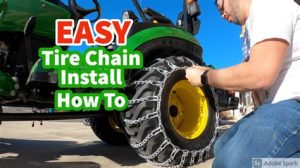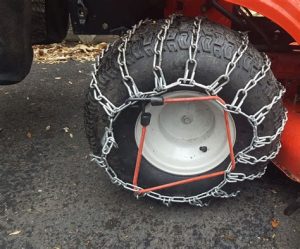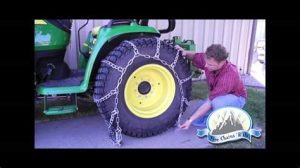Explore essential tips on selecting snow chains, including types, tire sizes, installation techniques, and factors like terrain and weather for optimal performance.When it comes to optimizing your tractor’s performance in challenging conditions, installing chains on your tires can make all the difference. Whether you’re navigating icy roads or muddy fields, the right tire chains enhance traction and stability, ensuring that your work goes smoothly. However, choosing the right chains involves a careful assessment of various factors. In this blog post, we’ll guide you through the essential elements to consider, starting with an understanding of the different types of chains available and how they relate to your tire size and tread. Additionally, we’ll discuss the importance of proper chain tension, take terrain and weather conditions into account, and share essential installation techniques. Equip yourself with the knowledge you need to make an informed decision and maximize your tractor’s capabilities, no matter the season!
Understanding the Types of Chains
When it comes to equipping your tractor with the appropriate tire chains, understanding the types of chains available is crucial. Different models are designed for various purposes, and knowing these can enhance traction, stability, and ultimately, performance.
- Link Chains: These are the most common and consist of metal links that wrap around the tire. They provide excellent grip on icy or snowy surfaces.
- Cable Chains: Made from steel cables, these chains are lighter and easier to install, but may not provide the same level of traction as link chains.
- Diamond Chains: Designed to remain on the tire longer and provide enhanced traction, these chains have a diamond-shaped pattern that distributes weight evenly.
- Cross Chains: These chains provide extra grip by adding cross pieces that create more points of contact with the ground.
Choosing the right type of chain depends largely on your specific needs, including the type of terrain you will encounter and the weather conditions you expect.
Assessing the Tire Size and Tread
When it comes to installing chains on tractor tires, the first step is assessing the tire size. Knowing the correct size ensures a proper fit and enhances the overall effectiveness of the chains. Tire sizes are usually marked on the sidewall and include numbers representing the tire’s width, aspect ratio, and diameter. For tractors, common sizes might look like 480/70R28, where each part provides crucial information for selecting the correct chains.
Next, understanding the tread pattern of your tires is equally important. Different tread designs provide varying levels of traction and handling on diverse terrains. For example, tires with deeper and more aggressive treads are suited for muddy or uneven surfaces, while those with a smoother surface are apt for roads or hard-packed conditions. This knowledge will help you choose chains that complement your tire’s tread for optimized performance.
Moreover, the material and build of the chains should also be compatible with your tire’s construction. Some chains are designed to work seamlessly with specific tread patterns, which allows for enhanced grip without compromising the tire’s integrity. By taking the time to assess both tire size and tread, you ensure that your tractor achieves maximum efficiency and safety during operations.
Choosing the Right Chain Tension
When it comes to installing chains on your tractor’s tires, one of the most critical factors is determining the right chain tension. Proper tension ensures that the chains function effectively, providing the necessary grip without causing damage to the tires or chains themselves. This section aims to guide you through the key considerations for achieving optimal chain tension.
Firstly, it’s essential to understand that loose chains can be dangerous. They are more likely to slip off during operation, which not only reduces traction but also poses a risk to the operator and any nearby individuals. On the other hand, chains that are too tight can lead to excessive wear on the tires, accelerate the fatigue of the chains, and can even damage the vehicle’s suspension system.
- Start by installing the chains correctly, ensuring that they are evenly distributed around the tire.
- Once installed, drive the tractor for a short distance (about 100 yards) to allow the chains to settle into place.
- After the initial drive, check the tension of the chains. They should be snug but not overly tight.
- Adjust the tension as needed, ensuring there is adequate clearance from the tire sidewalls and suspension components.
Remember, regularly checking the chain tension during use can save you time and prevent damage.
Considering the Terrain and Weather
When it comes to installing chains on tractor tires, one must carefully consider the terrain and weather conditions in which the tractor will be operating. Different environments can greatly affect how chains perform, making it essential to choose the right type based on specific conditions.
For instance, if you are working in muddy or soft ground, opting for wider chains can provide better floatation and traction, preventing the tire from sinking. Conversely, if you are navigating through rocky or hard-packed surfaces, choosing chains with a more robust design will offer enhanced durability and grip.
Additionally, weather conditions like snow and ice demand different chain specifications. Chains designed for winter conditions require specific patterns and sizes to effectively bite into the snow and provide stability on icy surfaces. Always assess the typical climatic conditions you will face, and select chains that will perform optimally.
Proper Installation Techniques
Installing chains on tractor tires requires careful attention to ensure optimal performance and safety. Proper installation techniques not only affect how well the chains grip the ground but also influence the longevity of both the chains and the tires.
1. Select the Right Size: Before installation, it is crucial to confirm that the chains are compatible with your tire size. Chains that are too tight or too loose can lead to issues such as damage during use or inefficient traction.
2. Clean Your Tires: Ensure that your tractor tires are free from debris, mud, and other materials. This will facilitate a smooth installation process and help the chains to lay well against the tire surface.
3. Lay Out the Chains: Before putting the chains on the tires, lay them out flat on the ground. This helps to untwist any links and avoid unnecessary stress during installation.
4. Positioning the Chains: Drape the chains over the top of the tire, ensuring that the links are evenly distributed on both sides. Make sure the cables or cross-links are pointed in the right direction to optimize traction.
5. Secure the Chains: Adjust the tension of the chains according to the manufacturer’s guidelines. Most chains come with tensioners or cams for tightening. Follow the instructions carefully to secure the chains without over-tightening, as this could lead to damage.
6. Test Drive: After installation, take a short test drive to ensure that the chains are mounted correctly. Listen for any unusual noises and check for any movement of the chains. If anything seems amiss, re-assess the installation.
By following these proper installation techniques, tractor operators can ensure better safety and functionality while using tire chains, which is especially essential during adverse weather conditions or when navigating challenging terrains.
Frequently Asked Questions
Why is it important to install chains on tractor tires?
Installing chains on tractor tires is essential for improving traction, stability, and safety, especially in snowy or muddy conditions.
What type of chains should I choose for my tractor tires?
The type of chains you choose should be compatible with your tire size and intended use, such as agricultural, forestry, or transport chains.
How do I determine the correct size of chains for my tractor tires?
To determine the correct size, refer to your tire’s specifications and select chains that match those dimensions.
Are all tire chains easy to install?
While many tire chains come with installation instructions, some may be easier to install than others. It’s important to choose chains designed for hassle-free installation.
Should I take any precautions when installing chains on tractor tires?
Yes, always ensure the tractor is on a flat surface, wear gloves for protection, and double-check the tension of the chains after installation.
How often should I check the condition of my tire chains?
You should inspect your tire chains regularly for signs of wear or damage, especially before and after use in harsh conditions.
Can tire chains damage my tractor tires?
If installed and maintained properly, tire chains typically do not damage tractor tires. However, excessive wear or improper installation can lead to issues.





